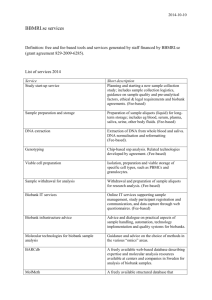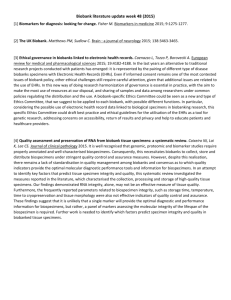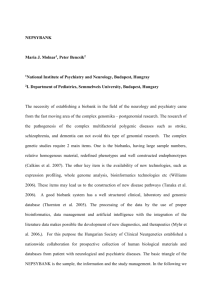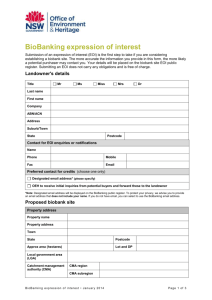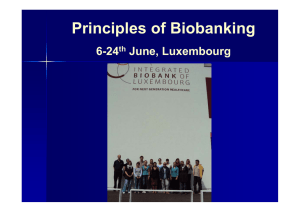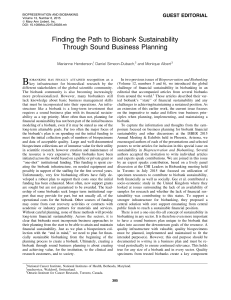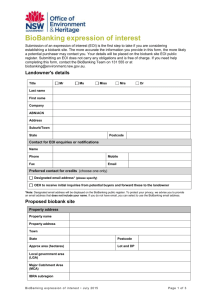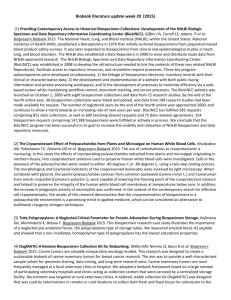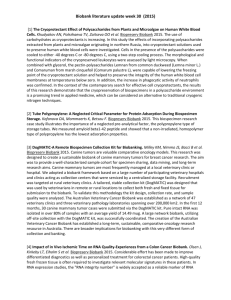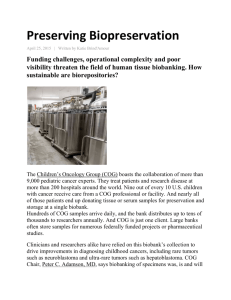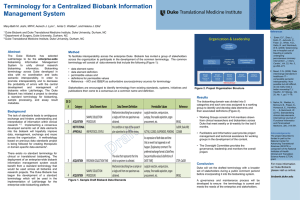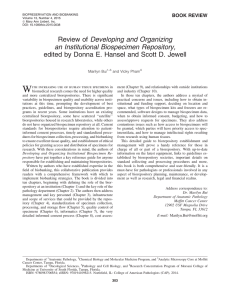Week 37 (2015-09-07)
advertisement
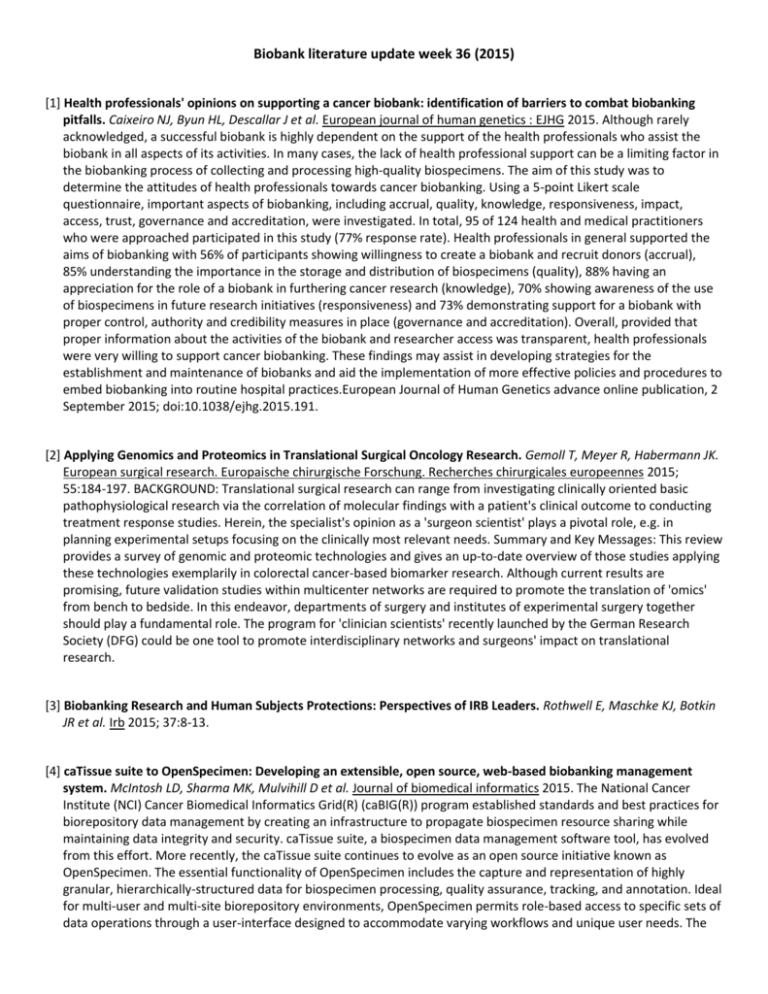
Biobank literature update week 36 (2015) [1] Health professionals' opinions on supporting a cancer biobank: identification of barriers to combat biobanking pitfalls. Caixeiro NJ, Byun HL, Descallar J et al. European journal of human genetics : EJHG 2015. Although rarely acknowledged, a successful biobank is highly dependent on the support of the health professionals who assist the biobank in all aspects of its activities. In many cases, the lack of health professional support can be a limiting factor in the biobanking process of collecting and processing high-quality biospecimens. The aim of this study was to determine the attitudes of health professionals towards cancer biobanking. Using a 5-point Likert scale questionnaire, important aspects of biobanking, including accrual, quality, knowledge, responsiveness, impact, access, trust, governance and accreditation, were investigated. In total, 95 of 124 health and medical practitioners who were approached participated in this study (77% response rate). Health professionals in general supported the aims of biobanking with 56% of participants showing willingness to create a biobank and recruit donors (accrual), 85% understanding the importance in the storage and distribution of biospecimens (quality), 88% having an appreciation for the role of a biobank in furthering cancer research (knowledge), 70% showing awareness of the use of biospecimens in future research initiatives (responsiveness) and 73% demonstrating support for a biobank with proper control, authority and credibility measures in place (governance and accreditation). Overall, provided that proper information about the activities of the biobank and researcher access was transparent, health professionals were very willing to support cancer biobanking. These findings may assist in developing strategies for the establishment and maintenance of biobanks and aid the implementation of more effective policies and procedures to embed biobanking into routine hospital practices.European Journal of Human Genetics advance online publication, 2 September 2015; doi:10.1038/ejhg.2015.191. [2] Applying Genomics and Proteomics in Translational Surgical Oncology Research. Gemoll T, Meyer R, Habermann JK. European surgical research. Europaische chirurgische Forschung. Recherches chirurgicales europeennes 2015; 55:184-197. BACKGROUND: Translational surgical research can range from investigating clinically oriented basic pathophysiological research via the correlation of molecular findings with a patient's clinical outcome to conducting treatment response studies. Herein, the specialist's opinion as a 'surgeon scientist' plays a pivotal role, e.g. in planning experimental setups focusing on the clinically most relevant needs. Summary and Key Messages: This review provides a survey of genomic and proteomic technologies and gives an up-to-date overview of those studies applying these technologies exemplarily in colorectal cancer-based biomarker research. Although current results are promising, future validation studies within multicenter networks are required to promote the translation of 'omics' from bench to bedside. In this endeavor, departments of surgery and institutes of experimental surgery together should play a fundamental role. The program for 'clinician scientists' recently launched by the German Research Society (DFG) could be one tool to promote interdisciplinary networks and surgeons' impact on translational research. [3] Biobanking Research and Human Subjects Protections: Perspectives of IRB Leaders. Rothwell E, Maschke KJ, Botkin JR et al. Irb 2015; 37:8-13. [4] caTissue suite to OpenSpecimen: Developing an extensible, open source, web-based biobanking management system. McIntosh LD, Sharma MK, Mulvihill D et al. Journal of biomedical informatics 2015. The National Cancer Institute (NCI) Cancer Biomedical Informatics Grid(R) (caBIG(R)) program established standards and best practices for biorepository data management by creating an infrastructure to propagate biospecimen resource sharing while maintaining data integrity and security. caTissue suite, a biospecimen data management software tool, has evolved from this effort. More recently, the caTissue suite continues to evolve as an open source initiative known as OpenSpecimen. The essential functionality of OpenSpecimen includes the capture and representation of highly granular, hierarchically-structured data for biospecimen processing, quality assurance, tracking, and annotation. Ideal for multi-user and multi-site biorepository environments, OpenSpecimen permits role-based access to specific sets of data operations through a user-interface designed to accommodate varying workflows and unique user needs. The Biobank literature update week 36 (2015) software is interoperable, both syntactically and semantically, with an array of other bioinformatics tools given its integration of standard vocabularies thus enabling research involving biospecimens. End-users are encouraged to share their day-to-day experiences in working with the application, thus providing to the community board insight into the needs and limitations which need be addressed. Users are also requested to review and validate new features through group testing environments and mock screens. Through this user interaction, application flexibility and interoperability have been recognized as necessary developmental focuses essential for accommodating diverse adoption scenarios and biobanking workflows to catalyze advances in biomedical research and operations. Given the diversity of biobanking practices and workforce roles, efforts have been made consistently to maintain robust data granularity while aiding user accessibility, data discoverability, and security within and across applications by providing a lower learning curve in using OpenSpecimen. Iterative development and testing cycles provide continuous maintenance and up-to-date capabilities for this freely available, open-access, web-based software application that is globally-adopted at over 25 institutions. [5] Integration of extracellular RNA profiling data using metadata, biomedical ontologies and Linked Data technologies. Subramanian SL, Kitchen RR, Alexander R et al. Journal of extracellular vesicles 2015; 4:27497. The large diversity and volume of extracellular RNA (exRNA) data that will form the basis of the exRNA Atlas generated by the Extracellular RNA Communication Consortium pose a substantial data integration challenge. We here present the strategy that is being implemented by the exRNA Data Management and Resource Repository, which employs metadata, biomedical ontologies and Linked Data technologies, such as Resource Description Framework to integrate a diverse set of exRNA profiles into an exRNA Atlas and enable integrative exRNA analysis. We focus on the following three specific data integration tasks: (a) selection of samples from a virtual biorepository for exRNA profiling and for inclusion in the exRNA Atlas; (b) retrieval of a data slice from the exRNA Atlas for integrative analysis and (c) interpretation of exRNA analysis results in the context of pathways and networks. As exRNA profiling gains wide adoption in the research community, we anticipate that the strategies discussed here will increasingly be required to enable data reuse and to facilitate integrative analysis of exRNA data. [6] [Elaboration of a national biobank for the study of gestational trophoblastic diseases]. Bolze PA, Massardier J, Buenerd A et al. Journal de gynecologie, obstetrique et biologie de la reproduction 2015. AIM: To generate a national biobank made up of samples of the highest quality for the purpose of inciting basic research on gestational trophoblastic diseases (GTD). MATERIAL AND METHODS: Three priority axes of research were defined to optimize the nature, method of collection, and storage of the samples. These are: to enhance our understanding of GTD, develop new diagnostic tests, and identify new therapeutic targets. The protocol for patient inclusion and sample processing was determined after extensive literature review and collaboration with international experts in the field of GTD. RESULTS: For each patient with a GTD and for control patients (legally induced abortions), chorionic villi, decidua and tumor samples (fresh, immersed in RNA-protective solution and fixed in formaldehyde), blood (serum, plasma, RNA, and peripheral blood mononuclear cells), urine (supernatant), and cell cultures of villous cytotrophoblasts are prospectively collected. Associations are then made between the collected samples and numerous clinical and biological data, such as human chorionic gonadotropic plasma levels following curettage in the case of a hydatidiform mole. CONCLUSION: Such a collection of high quality samples and their associated data open up new perspectives for both national and international collaborative research projects.
